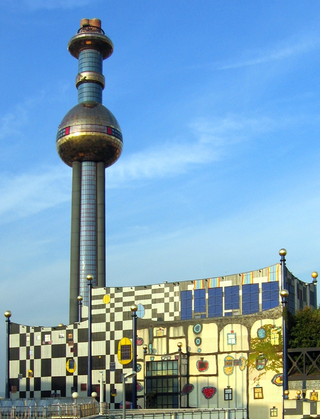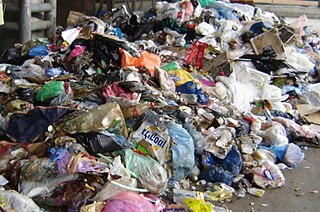Related Research Articles
Nuclear engineering is the engineering discipline concerned with designing and applying systems that utilize the energy released by nuclear processes. The most prominent application of nuclear engineering is the generation of electricity. Worldwide, some 440 nuclear reactors in 32 countries generate 10 percent of the world's energy through nuclear fission. In the future, it is expected that nuclear fusion will add another nuclear means of generating energy. Both reactions make use of the nuclear binding energy released when atomic nucleons are either separated (fission) or brought together (fusion). The energy available is given by the binding energy curve, and the amount generated is much greater than that generated through chemical reactions. Fission of 1 gram of uranium yields as much energy as burning 3 tons of coal or 600 gallons of fuel oil, without adding carbon dioxide to the atmosphere.

Waste management or waste disposal includes the processes and actions required to manage waste from its inception to its final disposal. This includes the collection, transport, treatment, and disposal of waste, together with monitoring and regulation of the waste management process and waste-related laws, technologies, and economic mechanisms.

A landfill site, also known as a tip, dump, rubbish dump, garbage dump, trash dump, or dumping ground, is a site for the disposal of waste materials. Landfill is the oldest and most common form of waste disposal, although the systematic burial of the waste with daily, intermediate and final covers only began in the 1940s. In the past, refuse was simply left in piles or thrown into pits; in archeology this is known as a midden.

Incineration is a waste treatment process that involves the combustion of substances contained in waste materials. Industrial plants for waste incineration are commonly referred to as waste-to-energy facilities. Incineration and other high-temperature waste treatment systems are described as "thermal treatment". Incineration of waste materials converts the waste into ash, flue gas and heat. The ash is mostly formed by the inorganic constituents of the waste and may take the form of solid lumps or particulates carried by the flue gas. The flue gases must be cleaned of gaseous and particulate pollutants before they are dispersed into the atmosphere. In some cases, the heat that is generated by incineration can be used to generate electric power.

Plastic recycling is the processing of plastic waste into other products. Recycling can reduce dependence on landfill, conserve resources and protect the environment from plastic pollution and greenhouse gas emissions. Recycling rates lag those of other recoverable materials, such as aluminium, glass and paper. From the start of production through to 2015, the world produced some 6.3 billion tonnes of plastic waste, only 9% of which has been recycled, and only ~1% has been recycled more than once. Of the remaining waste, 12% was incinerated and 79% either sent to landfill or lost into the environment as pollution.

Municipal solid waste (MSW), commonly known as trash or garbage in the United States and rubbish in Britain, is a waste type consisting of everyday items that are discarded by the public. "Garbage" can also refer specifically to food waste, as in a garbage disposal; the two are sometimes collected separately. In the European Union, the semantic definition is 'mixed municipal waste,' given waste code 20 03 01 in the European Waste Catalog. Although the waste may originate from a number of sources that has nothing to do with a municipality, the traditional role of municipalities in collecting and managing these kinds of waste have produced the particular etymology 'municipal.'

Waste-to-energy (WtE) or energy-from-waste (EfW) is the process of generating energy in the form of electricity and/or heat from the primary treatment of waste, or the processing of waste into a fuel source. WtE is a form of energy recovery. Most WtE processes generate electricity and/or heat directly through combustion, or produce a combustible fuel commodity, such as methane, methanol, ethanol or synthetic fuels, often derived from the product syngas.

South East London Combined Heat and Power, better known as SELCHP, is a major energy from waste incineration plant in South Bermondsey, London. It was designed to generate both heat and electricity. The plant can generate up to 35 MegaWatts of power using a steam turbine in electricity only mode. It can incinerate up to 420,000 tonnes per year of municipal solid waste.

The United States and the Republic of Kazakhstan established diplomatic relations on December 16, 1991. The United States opened its embassy in Almaty in January 1992 and then relocated to Astana in 2006.
Waste management in Japan today emphasizes not just the efficient and sanitary collection of waste, but also reduction in waste produced and recycling of waste when possible. This has been influenced by its history, particularly periods of significant economic expansion, as well as its geography as a mountainous country with limited space for landfills. Important forms of waste disposal include incineration, recycling and, to a smaller extent, landfills and land reclamation. Although Japan has made progress since the 1990s in reducing waste produced and encouraging recycling, there is still further progress to be made in reducing reliance on incinerators and the garbage sent to landfills. Challenges also exist in the processing of electronic waste and debris left after natural disasters.

Waste are unwanted or unusable materials. Waste is any substance discarded after primary use, or is worthless, defective and of no use. A by-product, by contrast is a joint product of relatively minor economic value. A waste product may become a by-product, joint product or resource through an invention that raises a waste product's value above zero.
Andrea Rossi is an Italian entrepreneur who claimed to have invented a cold fusion device.
UCL Australia was an international campus of the University College London, located on Victoria Square in Adelaide, South Australia. It had three parts: the School of Energy and Resources (SERAus), the International Energy Policy Institute (IEPI) and a branch of UCL's Mullard Space Science Laboratory. UCL Australia described its university community as "welcoming, dynamic and influential." The campus closed in December 2017.

The Lakeside EfW is located in Colnbrook, Slough. It incinerates residual waste, and since 2010 it has also been authorised to incinerate low-level radioactive waste.
Carbon8 Aggregates Ltd is a British company which applies patented "accelerated carbonation technology" to solidify waste residues produced by the incineration of garbage. Carbon8's accelerated carbonation processes make the wastes of garbage incineration cheaper to dispose of and produce aggregates which can then be used as construction materials. Carbon8 aggregates claim to be the world's first carbon negative aggregates. In 2012, the University of Greenwich said that the processes commercialised by Carbon8 Aggregates and its affiliate Carbon8 Systems also had potential use in the management of nuclear wastes. As of 2015, Carbon8 Aggregates are producing aggregates at a facility in Brandon, Suffolk and another facility at Avonmouth near Bristol is under construction.
David John Travers is a businessman from Sydney, Australia.
James 'Jim' Wilson Voss is an American senior nuclear engineer who has managed nuclear materials and radioactive waste since graduating from Arizona University in the 1970s. Voss became known to Australians through his managing directorship of Pangea Resources, a consortium which planned to establish a nuclear waste repository in Australia in the late 1990s. Pangea's proposal was ultimately rejected following the efforts of the anti-nuclear movement in Australia. Voss is currently working at UCL Australia as an Honorary Reader. As of 2015 Voss is a partner at Predicus Consulting and a director of companies in the USA and the United Kingdom.
Science and technology in Kazakhstan – government policies to develop science, technology and innovation in Kazakhstan.
Paola Lettieri is a British-Italian chemical engineer who is a Professor of Chemical Engineering and Pro-Provost of UCL East at University College London. Her research considers fluidisation and life-cycle assessment. She has developed novel, sustainable fluid-bed processes.

The Republic of Kazakhstan, once a republic of the Soviet Union, was a primary venue for Soviet nuclear weapon testing from 1949 until 1989. Following the collapse of the Union of Soviet Socialist Republics (USSR) in 1991, Kazakhstan became the fourth-largest nuclear power in the world and hosted a considerably large weapon support infrastructure due to its reliance on the Soviet nuclear program as a means to develop its own local economy. Besides the nuclear program, Kazakhstan was also a prominent site of Soviet programs of biological and chemical weapons.
References
- ↑ "Professor Stefaan Simons". www.ucl.ac.uk. Retrieved 29 May 2015.
- ↑ "Our Process". c8a.co.uk. Retrieved 2 June 2015.
- ↑ "University's 'green' invention to treat waste materials goes into commercial production | Engineering & Science | University of Greenwich". www2.gre.ac.uk. Retrieved 2 June 2015.
- ↑ "University's 'green' invention to treat waste materials goes into commercial production | Engineering & Science | University of Greenwich". www2.gre.ac.uk. Retrieved 2 June 2015.
- ↑ "Shocking infant mortality rates put Grundon's £100,000 donation to Colnbrook Village Hall under spotlight" . Retrieved 2 June 2015.
- ↑ "UK Health Research". www.ukhr.eu. Retrieved 2 June 2015.
- ↑ "Nuclear-powered submarines 'do-able' for Australia". www.ucl.ac.uk. Retrieved 29 May 2015.
- ↑ Simons, Stefaan. "Is it time for nuclear energy for Australia?" . Retrieved 29 May 2015.